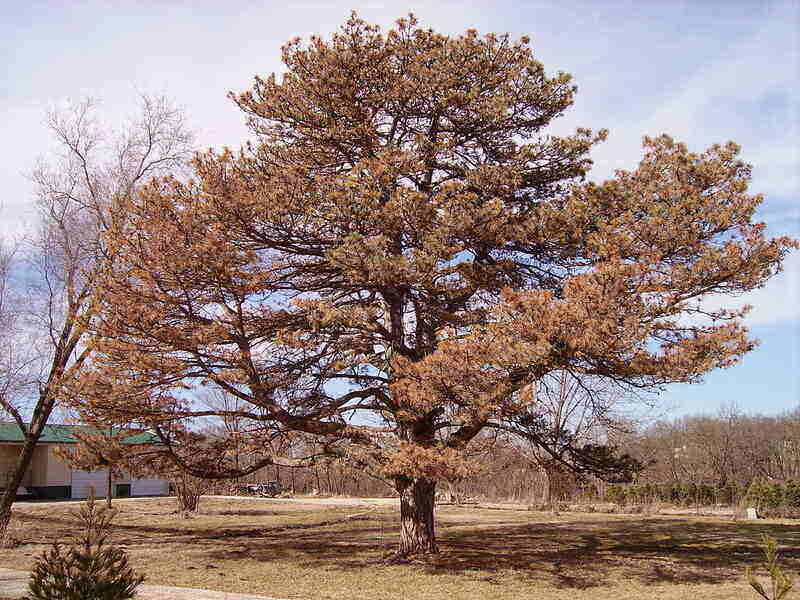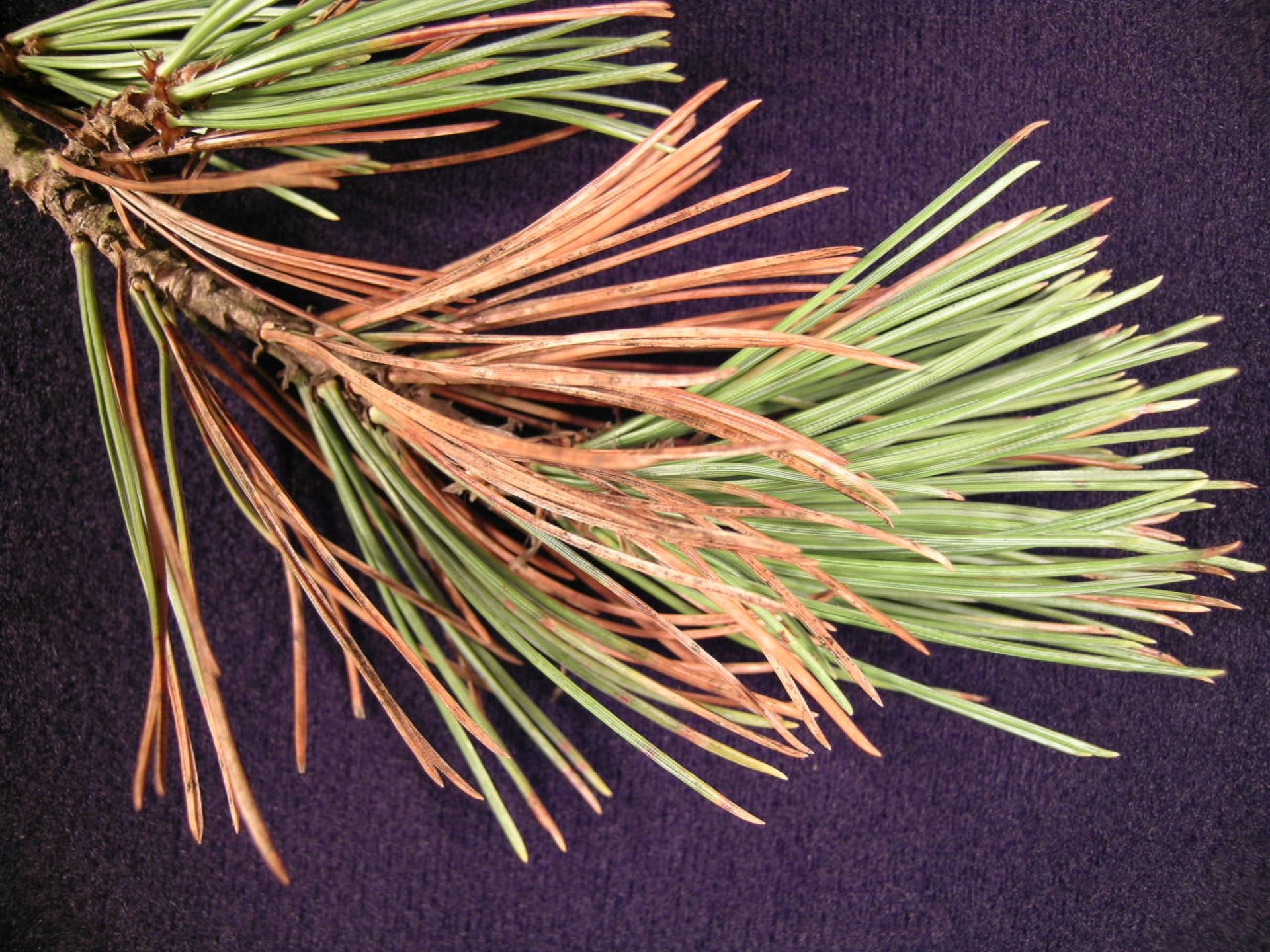Pine Tree Diseases
Welcome to Arbor Solutions Tree Service’s Pine Tree Disease page, where we delve into the various diseases that affect pine trees and provide insights on identification, prevention, and management strategies.
Pine trees are susceptible to a range of diseases caused by fungi, bacteria, and environmental stressors, which can compromise their health and vitality. Understanding the signs and symptoms of these diseases is essential for early detection and intervention to protect your pine trees from further damage.
Whether you’re a homeowner, landscaper, or forestry professional, our comprehensive resources and expert guidance will empower you to make informed decisions and take proactive steps to safeguard your pine trees against disease threats. Join us as we explore the common diseases that plague pine trees and learn how Arbor Solutions can help you effectively manage and mitigate these challenges for healthier, more resilient trees.
Disease Identification: Learn to recognize the signs and symptoms of common pine tree diseases, including fungal infections, bacterial diseases, and environmental stressors.
Early Detection: Understand the importance of early detection in preventing the spread of disease and minimizing damage to pine trees, enabling prompt intervention and treatment.
Prevention Strategies: Explore proactive measures to prevent pine tree diseases, such as proper tree care practices, soil management, and promoting tree vigor through adequate water, nutrients, and sunlight.
Management Techniques: Discover effective management techniques for controlling pine tree diseases, including cultural practices, pruning, chemical treatments, and biological controls.
Environmental Factors: Gain insights into the role of environmental factors, such as climate, soil conditions, and air pollution, in predisposing pine trees to disease and strategies for mitigating these risks.
Disease-Specific Information: Access detailed information on specific pine tree diseases, including their causes, symptoms, distribution, and recommended management approaches tailored to each disease.
Professional Consultation: Consult with our team of certified arborists and tree care experts for personalized recommendations and assistance in diagnosing, treating, and managing pine tree diseases on your property.
Diseases
Brown Spot Needle Blight
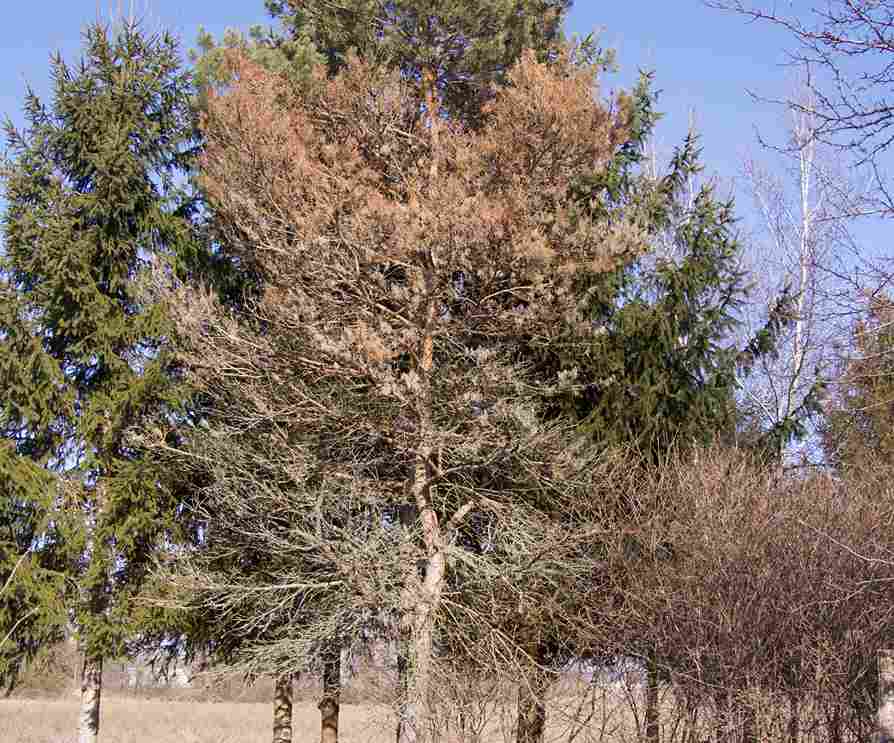
Pine Species Affected: Brown spot needle blight primarily targets loblolly pine (Pinus taeda), slash pine (Pinus elliottii), and longleaf pine (Pinus palustris), among other pine species commonly found in the southern United States.
Symptoms: Look for the appearance of brown or tan spots on pine needles, typically starting at the needle tip and progressing towards the base, accompanied by yellowing and premature needle drop.
Disease Spread: Brown spot needle blight spreads through splashing rain and wind-dispersed spores, thriving in warm, humid climates prevalent in the southern regions.
Impact on Tree Health: Left untreated, brown spot needle blight can lead to defoliation, reduced tree vigor, and in severe cases, branch dieback and tree decline, compromising the overall health and aesthetics of affected pine trees.
Cultural Management Practices: Implement cultural practices such as proper sanitation, including removal and disposal of infected needles and pruning of affected branches, to reduce disease pressure and limit spread within the stand.
Tree Vigor Promotion: Promote tree vigor through adequate water and nutrients, maintaining optimal growing conditions to enhance the tree's ability to withstand disease pressure and recover from infection.
Chemical Treatments: In severe cases or high-value tree stands, consider chemical treatments such as fungicides to suppress disease development and protect pine trees from brown spot needle blight.
Professional Consultation: Consult with certified arborists or tree care professionals for accurate diagnosis, tailored management recommendations, and assistance in implementing effective treatment strategies to combat brown spot needle blight and preserve the health and beauty of your pine trees
Pitch Canker
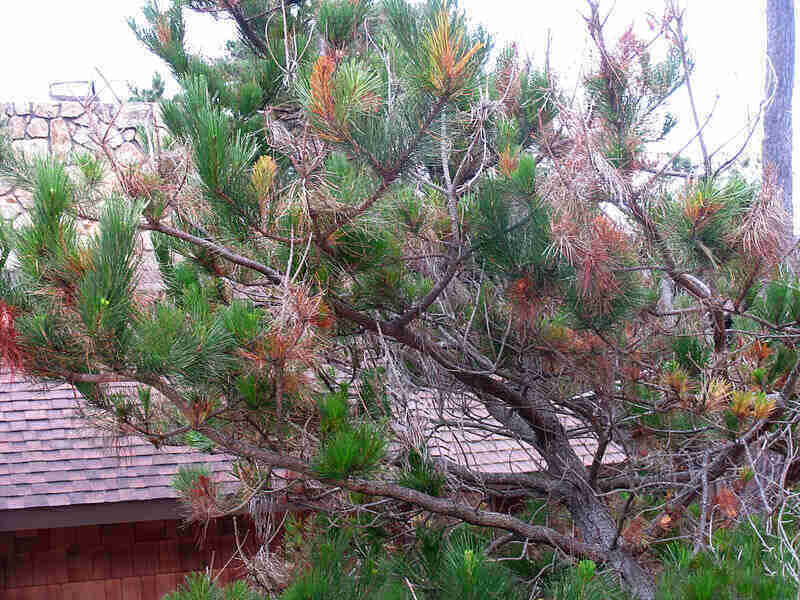
Pine Species Affected: Pitch canker primarily affects various pine species, including Monterey pine (Pinus radiata), loblolly pine (Pinus taeda), and slash pine (Pinus elliottii), among others.
Symptoms: Look for resinous cankers on branches and trunks, resin bleeding from the bark, dieback of shoots and foliage, and overall decline in tree health and vigor.
Disease Spread: Pitch canker spreads through infected pruning tools, wind-blown rain, and movement of contaminated soil, making it challenging to control and contain.
Environmental Factors: Environmental stressors such as drought, high temperatures, and poor soil drainage can exacerbate pitch canker symptoms and increase tree susceptibility to infection.
Management Strategies: Implement preventative measures such as sanitation practices to limit disease spread, removal and disposal of infected trees, and selection of resistant tree varieties to mitigate the impact of pitch canker.
Chemical Treatments: In severe cases or high-value tree stands, consider chemical treatments such as fungicides to suppress disease development and protect pine trees from pitch canker.
Professional Consultation: Consult with certified arborists or tree care professionals for accurate diagnosis, tailored management recommendations, and assistance in implementing effective treatment strategies to combat pitch canker and preserve the health and integrity of your pine trees.
Needle Rust
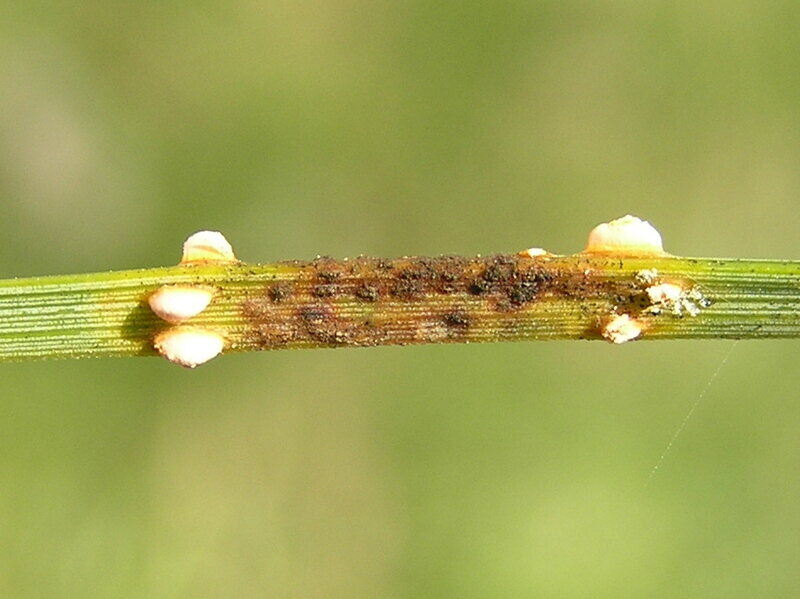
Pine Species Affected: Needle rust affects various pine species, including ponderosa pine (Pinus ponderosa), lodgepole pine (Pinus contorta), and Scots pine (Pinus sylvestris), among others.
Symptoms: Look for yellow to orange spots or swellings on pine needles, which eventually develop into small, powdery pustules containing fungal spores.
Disease Spread: Needle rust spreads through wind or rain-dispersed fungal spores, infecting nearby pine trees and perpetuating the disease cycle.
Impact on Tree Health: Needle rust infections can lead to premature needle drop, reduced tree vigor, and aesthetic decline, particularly in young or stressed trees.
Cultural Management Practices: Promote tree vigor through proper watering and fertilization to enhance the tree's ability to resist disease, and practice sanitation to remove and dispose of infected needles to reduce disease pressure.
Chemical Treatments: In severe cases or high-value tree stands, consider chemical treatments such as fungicides to suppress disease development and protect pine trees from needle rust.
Professional Consultation: Consult with certified arborists or tree care professionals for accurate diagnosis, tailored management recommendations, and assistance in implementing effective treatment strategies to combat needle rust and preserve the health and aesthetics of your pine trees.
Annosus Root Rot
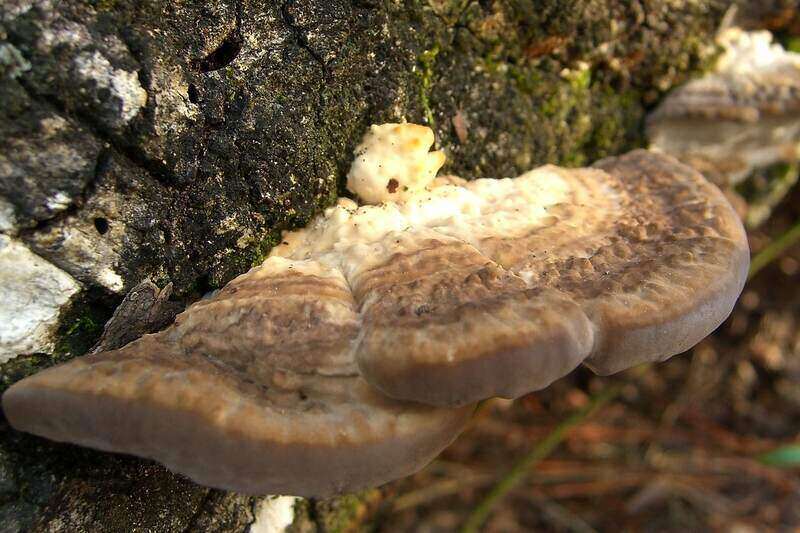
Tree Species Affected: Annosus root rot primarily affects coniferous trees, including pine species such as ponderosa pine (Pinus ponderosa) and lodgepole pine (Pinus contorta).
Symptoms: Look for thinning crowns, reduced growth, and the presence of conks or fungal fruiting bodies near the base of infected trees, indicating decay and structural instability in the roots.
Disease Spread: Annosus root rot spreads through root-to-root contact or airborne spores, often infecting neighboring trees in close proximity.
Impact on Tree Health: Annosus root rot can lead to tree decline and mortality, compromising the stability and health of affected pine trees, particularly in older or stressed specimens.
Preventative Measures: Implement sanitation practices to remove and dispose of infected trees or tree debris, maintain proper tree spacing to reduce root-to-root contact, and avoid injury to tree roots during construction or landscaping activities.
Chemical Treatments: In high-risk areas or valuable tree stands, consider chemical treatments such as fungicides or tree injections to suppress disease development and protect pine trees from annosus root rot.
Professional Consultation: Consult with certified arborists or tree care professionals for accurate diagnosis, tailored management recommendations, and assistance in implementing effective treatment strategies to combat annosus root rot and preserve the health and stability of your pine trees and landscape.
Cotton Root Rot
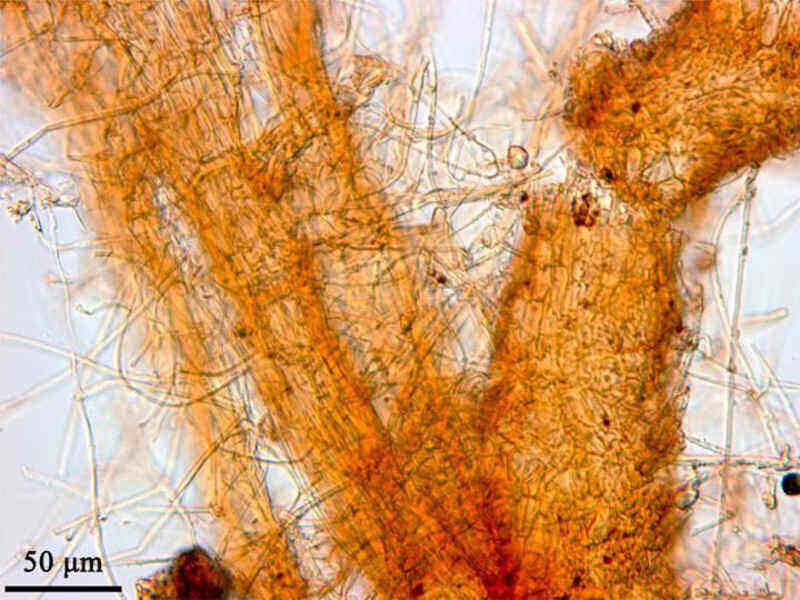
Tree Species Affected: Cotton root rot can affect various woody plants, including pine species such as loblolly pine (Pinus taeda) and shortleaf pine (Pinus echinata).
Symptoms: Look for wilting, yellowing, and sudden death of foliage, often accompanied by dark, decayed roots, indicating extensive root rot caused by cotton root rot.
Disease Spread: Cotton root rot is caused by the soil-borne fungus Phymatotrichopsis omnivora and thrives in warm, arid environments with alkaline soils, making it particularly problematic in regions with these conditions.
Environmental Factors: Soil drainage, moisture levels, and soil pH play significant roles in the development and spread of cotton root rot, with alkaline soils and poor drainage increasing susceptibility to infection.
Prevention Measures: Improve soil drainage, avoid overwatering, and select resistant tree varieties to reduce the risk of cotton root rot infection and minimize tree loss.
Control Measures: Control options for cotton root rot are limited, with preventative measures being the most effective approach to managing the disease and protecting pine trees from infection.
Professional Consultation: Consult with certified arborists or tree care professionals for accurate diagnosis, tailored management recommendations, and assistance in implementing effective prevention strategies to minimize the impact of cotton root rot on your pine trees and landscape.
Damping-off
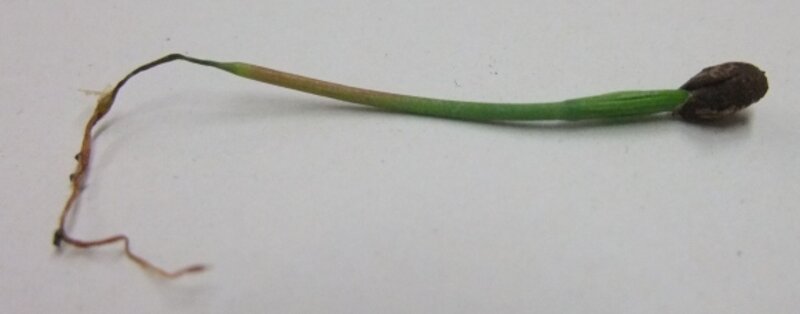
Target Seedlings: Damping-off primarily affects young seedlings and recently germinated seeds, hindering the establishment of healthy pine tree populations.
Causal Pathogens: Various soil-borne pathogens such as Pythium and Rhizoctonia contribute to damping-off, resulting in symptoms like seedling collapse, darkened stems, and root rot.
Environmental Conditions: Damping-off thrives in cool, wet environments and poorly-drained soils, making it prevalent in nursery settings or areas with high moisture levels.
Symptoms: Look for sudden seedling death, stunted growth, and characteristic signs of seedling collapse, including darkened, water-soaked stems and root rot.
Prevention Strategies: Implement preventative measures such as proper seedbed preparation, ensuring adequate drainage, maintaining sanitation practices, and utilizing well-drained growing media to minimize the risk of damping-off in pine seedlings.
Control Measures: Control options for cotton root rot are limited, with preventative measures being the most effective approach to managing the disease and protecting pine trees from infection.
Professional Guidance: Arbor Solutions Tree Service offers expert guidance and management strategies for damping-off, assisting in protecting young pine seedlings and ensuring the successful establishment and health of pine tree populations.
Diplodia Tip Blight
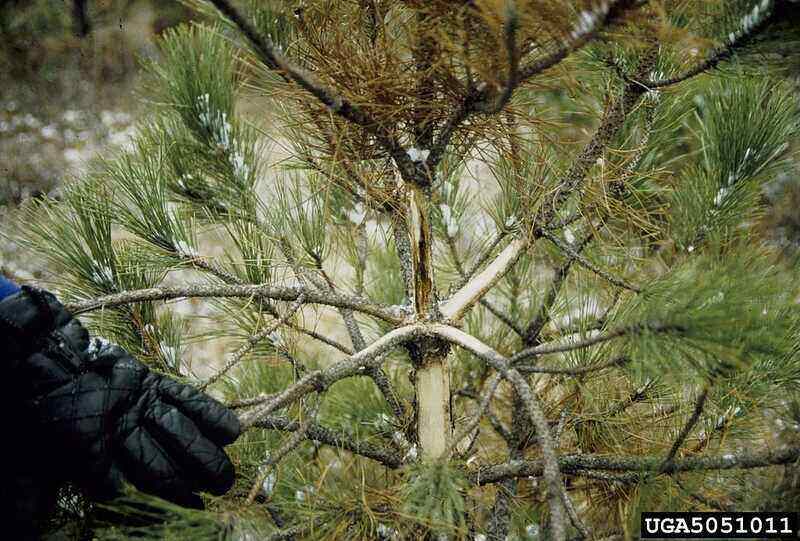
Pine Species Affected: Diplodia tip blight affects various pine species, including Austrian pine (Pinus nigra) and Scots pine (Pinus sylvestris), among others.
Symptoms: Look for stunted shoot growth, dieback of needles, and the formation of black fruiting bodies or "spore pustules" on infected needles, particularly on the growing tips of pine branches.
Environmental Factors: Diplodia tip blight becomes more pronounced during periods of stress, such as drought or excessive moisture, making it a common concern in landscapes with poor soil drainage or inadequate air circulation.
Disease Spread: The fungus Diplodia pinea spreads through wind-dispersed spores and thrives in environments conducive to pine tree growth, often infecting neighboring trees in close proximity.
Prevention Measures: Implement preventative measures such as proper pruning techniques to remove infected branches, promoting tree vigor through adequate watering and fertilization, and removing and disposing of infected plant material to reduce disease pressure.
Control Measures: Control options for cotton root rot are limited, with preventative measures being the most effective approach to managing the disease and protecting pine trees from infection.
Professional Consultation: Consult with certified arborists or tree care professionals for accurate diagnosis, tailored management recommendations, and assistance in implementing effective treatment strategies to combat Diplodia tip blight and preserve the health and beauty of your pine trees and landscape.
Dothistroma Needle Blight
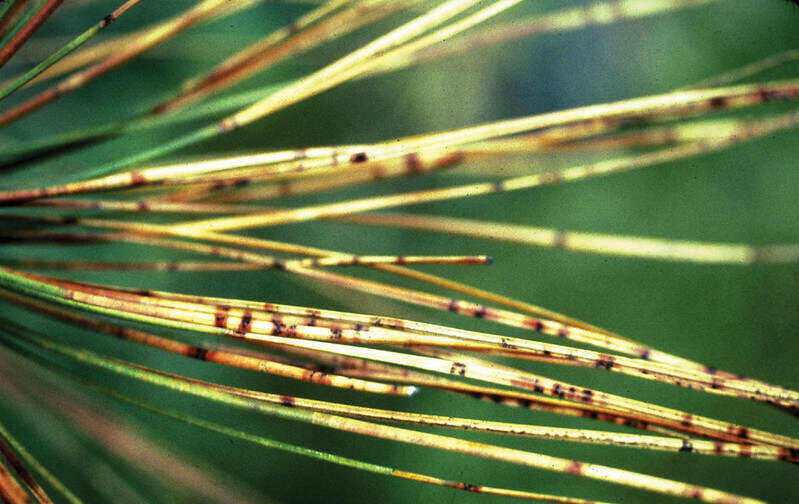
Pine Species Affected: Dothistroma needle blight affects various pine species, including ponderosa pine (Pinus ponderosa) and Austrian pine (Pinus nigra), among others.
Symptoms: Look for yellowing, browning, and premature needle drop, starting from the lower branches and progressing upwards, along with the development of characteristic "dothistroma spots" containing black fruiting bodies or pycnidia on the needles.
Environmental Factors: Dothistroma needle blight thrives in warm, humid conditions and spreads through rain-splash or wind-dispersed spores, making it particularly problematic in regions with these climatic conditions.
Disease Spread: The fungus Dothistroma septosporum spreads through infected needles and can be further disseminated through rain-splash or wind, potentially infecting neighboring trees in close proximity.
Prevention Measures: Implement preventative measures such as promoting tree vigor through proper watering and fertilization, maintaining good air circulation, and promptly removing and disposing of infected needles to reduce disease pressure.
Professional Consultation: Consult with certified arborists or tree care professionals for accurate diagnosis, tailored management recommendations, and assistance in implementing effective treatment strategies to combat Dothistroma needle blight and preserve the health and aesthetics of your pine trees and landscape.
Fusiform Rust
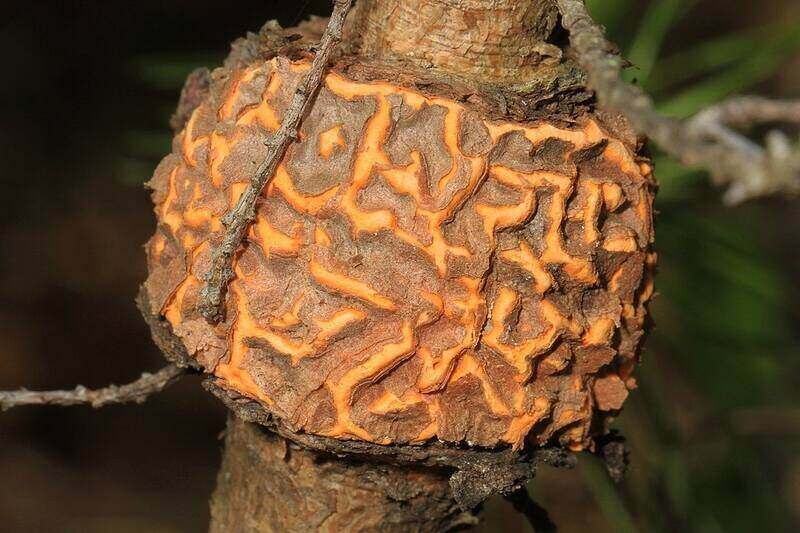
Pine Species Affected: Fusiform rust primarily affects various pine species, including loblolly pine (Pinus taeda) and slash pine (Pinus elliottii), among others.
Symptoms: Look for characteristic "fusiform" or spindle-shaped swellings on the stems and branches of infected pine trees, indicating the presence of the fungus Cronartium quercuum f. sp. fusiforme.
Disease Cycle: Fusiform rust involves alternate hosts, such as oak species, contributing to the spread and persistence of the fungus in the environment, making control measures challenging.
Economic Impact: Fusiform rust can cause extensive damage to pine stands, compromising tree health, wood quality, and resulting in significant economic losses in forestry operations.
Prevention Measures: Implement preventative strategies such as genetic resistance breeding, promoting tree vigor through proper cultural practices, and sanitation (removal and disposal of infected trees) to reduce disease pressure and minimize the impact of fusiform rust.
Chemical Treatments: In some cases, fungicides may be applied to infected trees to suppress the spread of the disease. However, this approach is often limited to high-value stands and may not be feasible on a large scale.
Professional Consultation: Consult with certified arborists or tree care professionals for accurate diagnosis, tailored management recommendations, and assistance in implementing effective treatment strategies to combat fusiform rust and preserve the health and productivity of your pine trees and forest.
Pine Wilt
